We were in Florence for four days.
- The Duomo:
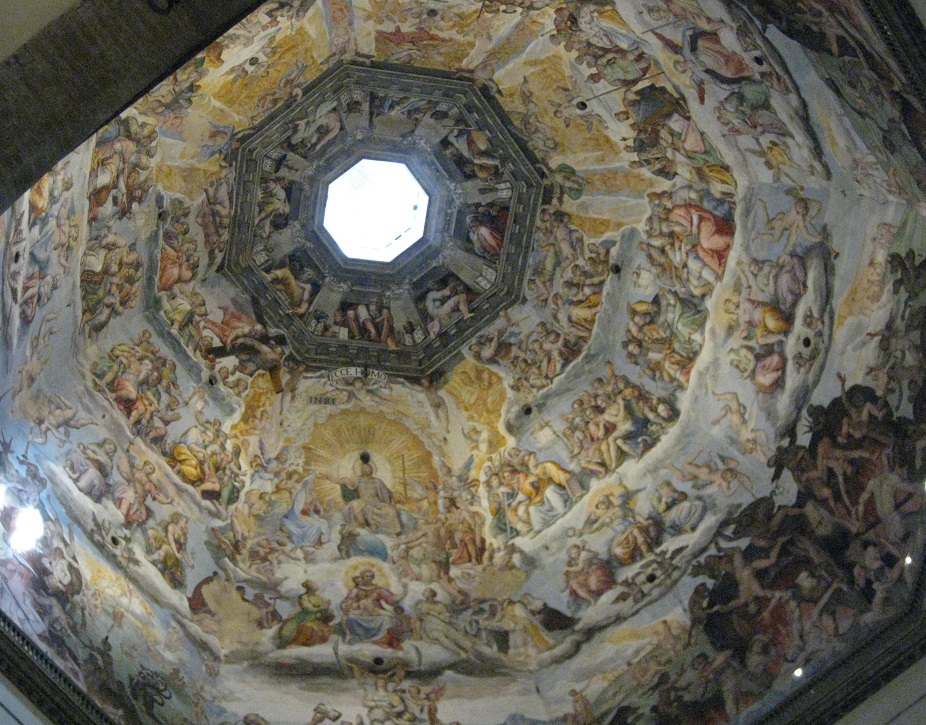 Unlike the Duomo in Milan, which has multiple dozen chapels along the outside, each with very detailed ornamentation, this Duomo is fairly plain. Its primary feature is a large ceiling fresco. It was nice, if slightly deflating after the Milan experience. (It also didn’t help that I lost my temper with the ladies selling scarves to those in line to go in. I was wearing a tank top, but I had my own scarf with me; however, they would not leave me alone, even after I told them – in Italian – that I already had a scarf.) The outside of the church was more interesting: it even featured a creepy-looking Pope statue inset into the front.
Unlike the Duomo in Milan, which has multiple dozen chapels along the outside, each with very detailed ornamentation, this Duomo is fairly plain. Its primary feature is a large ceiling fresco. It was nice, if slightly deflating after the Milan experience. (It also didn’t help that I lost my temper with the ladies selling scarves to those in line to go in. I was wearing a tank top, but I had my own scarf with me; however, they would not leave me alone, even after I told them – in Italian – that I already had a scarf.) The outside of the church was more interesting: it even featured a creepy-looking Pope statue inset into the front. - The Duomo’s Campanile: The most fun part of the Duomo was its Campanile, or tower, which stands next to it. We climbed all 422 stairs to the top, stopping at each level to take photos and enjoy the view. The stairs themselves were intimate: the higher up the winding staircase you got, the more you needed to press yourself into the stone walls to let someone pass. Surprisingly fun – even in spite of the calf workout.
- Bardini Garden:
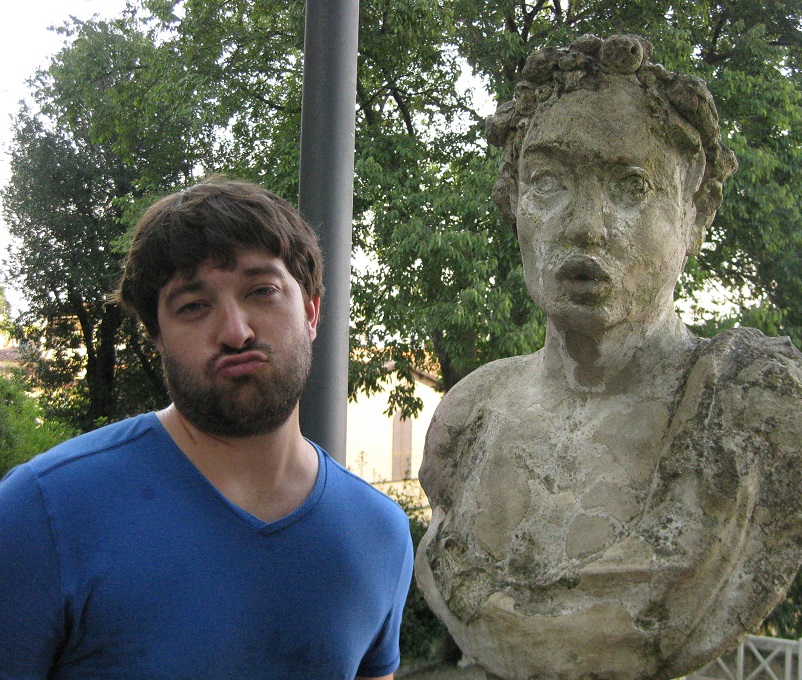 We wanted to go for a quick amble, so we picked this smaller and lesser-known park. Little did we know that it was built up the side of a big hill. We managed to drag our tired selves up there, for some nice views, some interesting statues, and a good breeze.
We wanted to go for a quick amble, so we picked this smaller and lesser-known park. Little did we know that it was built up the side of a big hill. We managed to drag our tired selves up there, for some nice views, some interesting statues, and a good breeze. - Boboli Gardens: This was free with the Bardini Garden ticket (Aside: since when does it cost money to visit a garden?), so we went. This place was very big, also with sloping hills and landscaping. Lots of statues, but the most interesting ones were the fake leaf-less trees, which were holding up fake boulders between the branches. It did look pretty cool, though I don’t really understand the intention. Is it a commentary on how humans weigh down their increasingly-barren planet? Or just an artist’s hope that a tourist will get smashed by a falling rock, and art insurance will cover it? The other exciting part of this garden was the trouble we had getting out.
 When we were ready to move on, we returned to the place we had entered, to find it locked. The fencing was quite tall and not the rinky dink kind, so we trekked to the other corner of the park – only to find that locked as well. Every new place we turned, we found blockaded exits. B’s doomsday scenarios about being stuck inside were just about to devolve into eating the plankton in the moldy fountains when we heard a loudspeaker announcement. It was the garden, telling us in four different languages that it would be closing in the next 10 minutes, so we should proceed to the ‘nearest exit.’ I started talking back to said loudspeakers because at no point in their English/French/Italian/Spanish announcement (that repeated endlessly) did they actually say where these mysterious exits were. We were actually starting to get nervous, and we could see no obvious way out. Others in the park were similarly confused, including a family with a stroller who spoke Spanish. B finally found an exit on Google Maps, and we happily complied with the audio directions. On the plus side, we saw much more of this park than we expected to.
When we were ready to move on, we returned to the place we had entered, to find it locked. The fencing was quite tall and not the rinky dink kind, so we trekked to the other corner of the park – only to find that locked as well. Every new place we turned, we found blockaded exits. B’s doomsday scenarios about being stuck inside were just about to devolve into eating the plankton in the moldy fountains when we heard a loudspeaker announcement. It was the garden, telling us in four different languages that it would be closing in the next 10 minutes, so we should proceed to the ‘nearest exit.’ I started talking back to said loudspeakers because at no point in their English/French/Italian/Spanish announcement (that repeated endlessly) did they actually say where these mysterious exits were. We were actually starting to get nervous, and we could see no obvious way out. Others in the park were similarly confused, including a family with a stroller who spoke Spanish. B finally found an exit on Google Maps, and we happily complied with the audio directions. On the plus side, we saw much more of this park than we expected to. - Great Synagogue of Florence: This is one of the only synagogues I have ever seen which is this ornate: not too dissimilar from the churches in Florence.
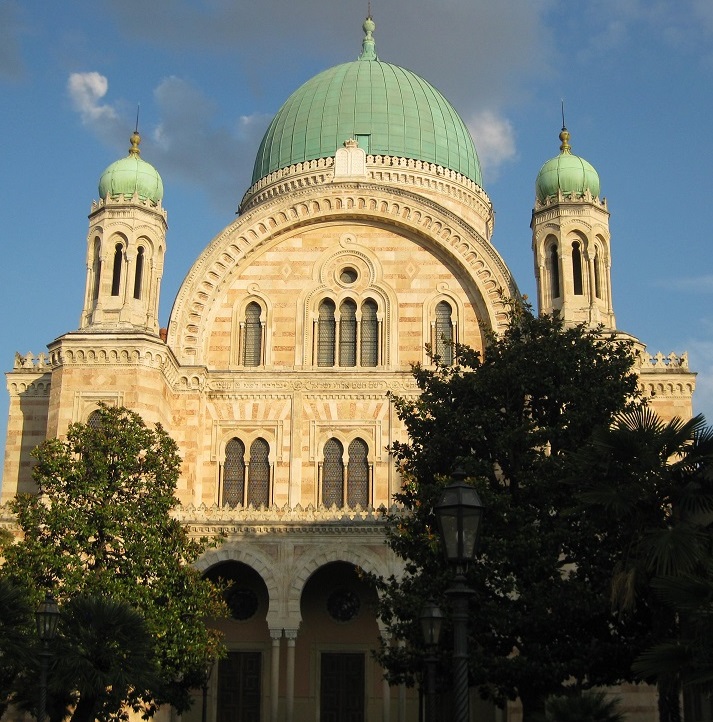 The large dome is green, having once been copper, and there are decorations both inside and out. There are also memorials to Italians killed in the Holocaust, and a fully-functioning synagogue which – by my estimate only – seems like it could fit a few thousand people. The upstairs houses a museum, with artifacts that are like the Jewish equivalents to baptism dresses, wine chalices, Bible covers, etc. There are also descriptions of various Jewish foods, overall and for specific holidays. I especially enjoyed the confusion and horror expressed in Italian on the Passover poster, as it describes the difficulty of eating neither bread, nor pizza, nor pasta for over a week! No photos of the inside allowed, but here’s one of the exterior.
The large dome is green, having once been copper, and there are decorations both inside and out. There are also memorials to Italians killed in the Holocaust, and a fully-functioning synagogue which – by my estimate only – seems like it could fit a few thousand people. The upstairs houses a museum, with artifacts that are like the Jewish equivalents to baptism dresses, wine chalices, Bible covers, etc. There are also descriptions of various Jewish foods, overall and for specific holidays. I especially enjoyed the confusion and horror expressed in Italian on the Passover poster, as it describes the difficulty of eating neither bread, nor pizza, nor pasta for over a week! No photos of the inside allowed, but here’s one of the exterior. - Galleria dell’Accademia:
 This is the museum which houses Michelangelo’s David. Surprisingly, unlike the Mona Lisa, it’s not packed like a subway car during rush hour. Don’t get me wrong: there are plenty of people, but there is enough space to walk around the statue, sit and stare at it, and pose with it. I was most amused by the three girls in their early 20s, posing as though they were cupping the statue’s genitalia – while wearing fancy dresses and heels. Very classy. B was very impressed with the statue; he found the artistry to be amazing, given the size of the work. I was unfortunately less impressed. Certainly, there was attention paid to the details, and I didn’t even mind the lack of proportionality of his right hand; I just felt that other sculptures demonstrated more emotion and even grasp of kinesiology.
This is the museum which houses Michelangelo’s David. Surprisingly, unlike the Mona Lisa, it’s not packed like a subway car during rush hour. Don’t get me wrong: there are plenty of people, but there is enough space to walk around the statue, sit and stare at it, and pose with it. I was most amused by the three girls in their early 20s, posing as though they were cupping the statue’s genitalia – while wearing fancy dresses and heels. Very classy. B was very impressed with the statue; he found the artistry to be amazing, given the size of the work. I was unfortunately less impressed. Certainly, there was attention paid to the details, and I didn’t even mind the lack of proportionality of his right hand; I just felt that other sculptures demonstrated more emotion and even grasp of kinesiology. 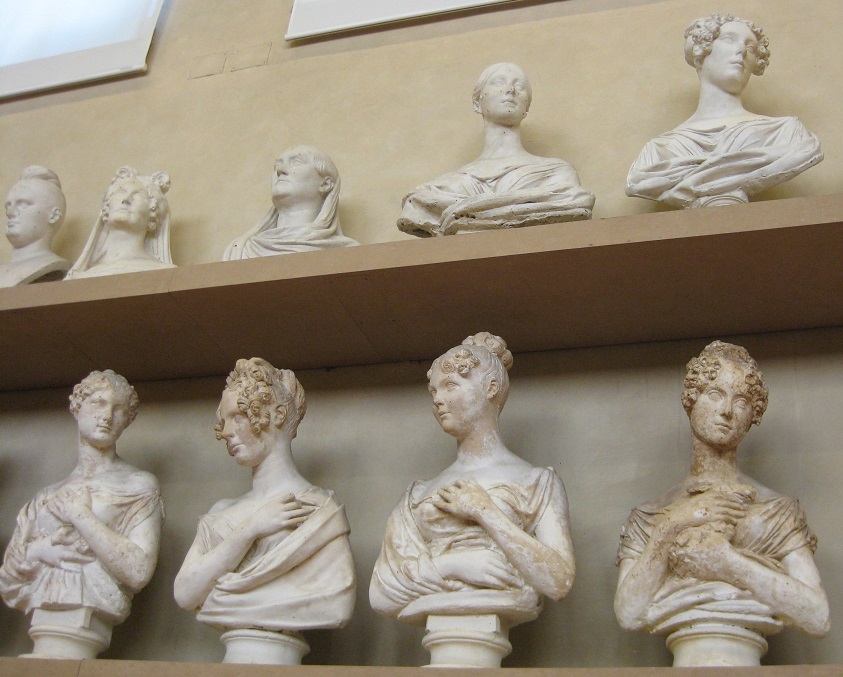 The museum also houses a number of other works, from religious paintings to more modern ones and sculptures of various kinds. I most enjoyed one big room they had for white marble statues. I’m still not sure why many of them had nails in them, but it was interesting to see such a range of subjects. And, there was a very cool exhibit on changing fashion and hairstyle trends in each decade of the 1800s. Given my proclivity for reading romance novels set in that time period, I am surprisingly educated on this topic.
The museum also houses a number of other works, from religious paintings to more modern ones and sculptures of various kinds. I most enjoyed one big room they had for white marble statues. I’m still not sure why many of them had nails in them, but it was interesting to see such a range of subjects. And, there was a very cool exhibit on changing fashion and hairstyle trends in each decade of the 1800s. Given my proclivity for reading romance novels set in that time period, I am surprisingly educated on this topic. - Santa Croce: This was
 an interesting church, in that half of it was a crypt. Many illustrious Florentines were buried here, from Galileo and Michelangelo to Machiaveli and some lesser-known Bonapartes. Even more people had plaques dedicated to them inside the church, like Marconi (inventor of the radio) and Dante Alighieri, over whose bones there’s been quite the battle. Like the Milan Duomo, it had a number of chapels off to the side, along with frescoes and stained glass. There was also an attached addition with a chapel for those who lived there and one for the Medici family. Also attached was the leather workshop, plus a garden in the back.
an interesting church, in that half of it was a crypt. Many illustrious Florentines were buried here, from Galileo and Michelangelo to Machiaveli and some lesser-known Bonapartes. Even more people had plaques dedicated to them inside the church, like Marconi (inventor of the radio) and Dante Alighieri, over whose bones there’s been quite the battle. Like the Milan Duomo, it had a number of chapels off to the side, along with frescoes and stained glass. There was also an attached addition with a chapel for those who lived there and one for the Medici family. Also attached was the leather workshop, plus a garden in the back. - Leather Workshop of Santa Croce:
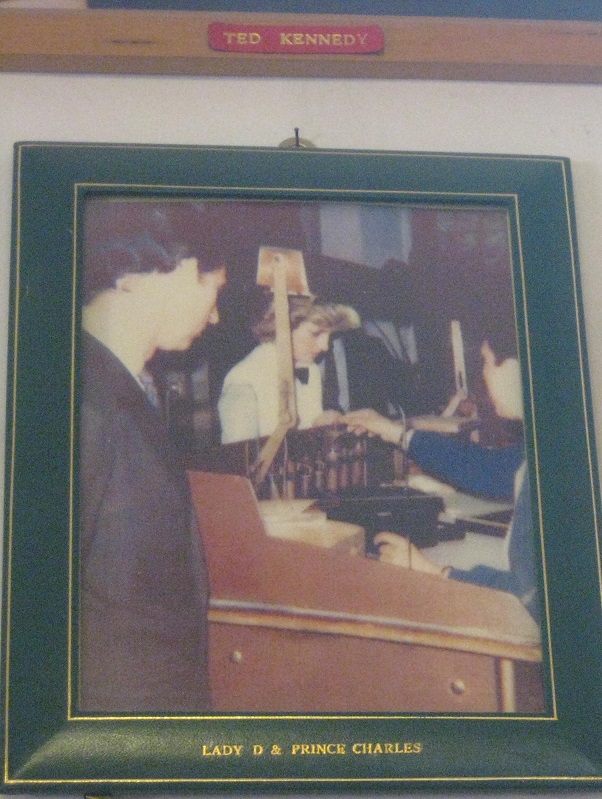 Originally formed to give poor and orphaned local children a vocation, this workshop became somewhat obsolete when free education for all Italians began and when leather began to be mass-produced in Asia. Now, they focus on making unique leather items and tourism from the church. A number of famous people have come to visit, from Barbara Bush and Princess Di to Will Smith and Neil Patrick Harris: they had photos up on the wall. We were spellbound by a video of one of their artisans making a book binding/ cover in the 80s: such precision and care. Watching the live artisans was less intriguing because one was mostly turning completed purses inside out, cutting off extra fabric and singeing the ends of strings. But it was admirable to see how much the family of the founder had persevered, given such change in the market.
Originally formed to give poor and orphaned local children a vocation, this workshop became somewhat obsolete when free education for all Italians began and when leather began to be mass-produced in Asia. Now, they focus on making unique leather items and tourism from the church. A number of famous people have come to visit, from Barbara Bush and Princess Di to Will Smith and Neil Patrick Harris: they had photos up on the wall. We were spellbound by a video of one of their artisans making a book binding/ cover in the 80s: such precision and care. Watching the live artisans was less intriguing because one was mostly turning completed purses inside out, cutting off extra fabric and singeing the ends of strings. But it was admirable to see how much the family of the founder had persevered, given such change in the market. - Uffizi Gallery: This is the gallery that Florence is known for. While I knew that, I couldn’t have told you why until after we stood in line for an hour and saw every open room. It’s a big sculpture gallery, with a smattering of paintings – including ‘The Birth of Venus’ and the ‘Holy Family,’ one of Michelangelo’s only paintings. The layout is strictly a bust-bust-full statue progression, which can be a bit tiring. However, there were some unusual ones to prompt debate: two full-length statues showing someone supposedly skinned alive (a story from mythology) and a giant wart hog that many are obsessed with. There was a special exhibit trying to make a point about how Florentine art wasn’t all the same and that it embraced both tradition and modernity/change; I was not convinced in the least. Of course, after three hours, perhaps I was a bit biased on that score. Definitely worth going to, but pack a power bar.
- Bargello Museum: This
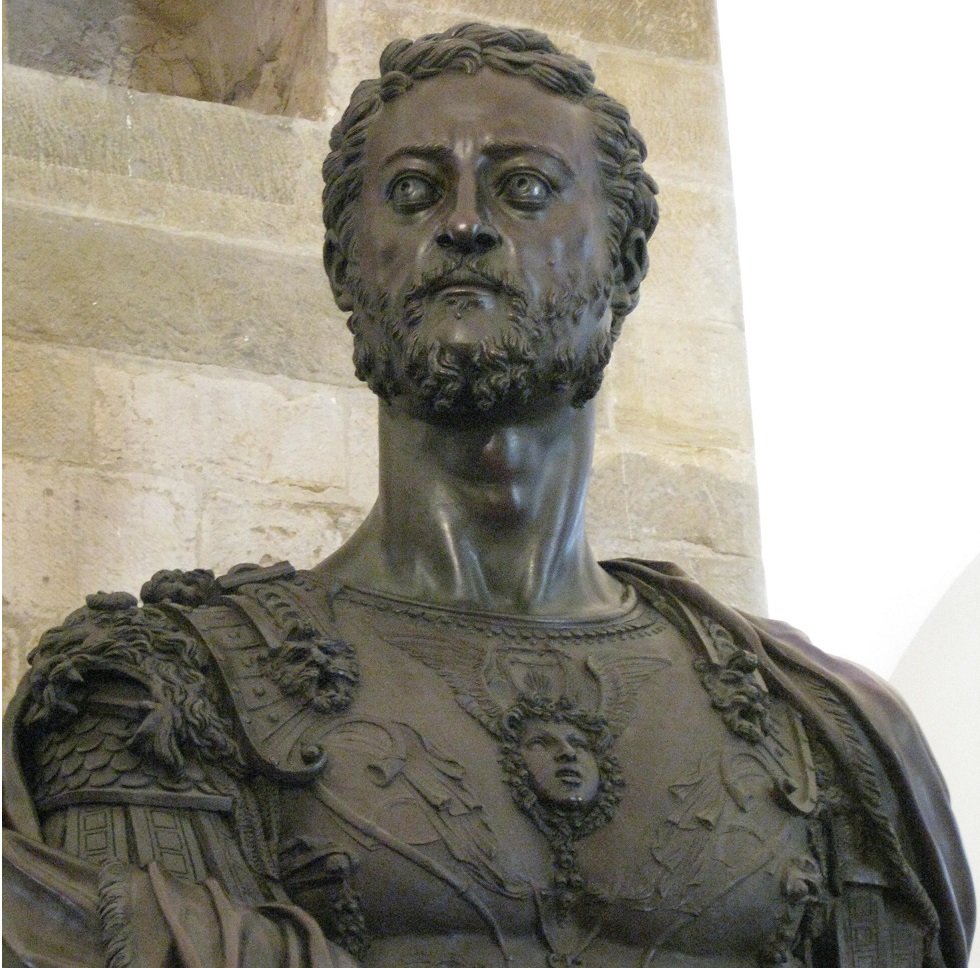 museum was once used as a prison, though it’s been restored to the pre-jail state so well that it’s hard to detect anything. It houses quite a few statues, including some by Michelangelo. B and I both appreciated this one of Cosimo I, the Medici Grand Duke, because of the look on his face. There were a lot of fairly random things upstairs too, from a leather purse and one small room of Muslim art to a chapel-looking room said to be home to the first depiction of Dante’s face, in a fresco which was painted over during the prison era.
museum was once used as a prison, though it’s been restored to the pre-jail state so well that it’s hard to detect anything. It houses quite a few statues, including some by Michelangelo. B and I both appreciated this one of Cosimo I, the Medici Grand Duke, because of the look on his face. There were a lot of fairly random things upstairs too, from a leather purse and one small room of Muslim art to a chapel-looking room said to be home to the first depiction of Dante’s face, in a fresco which was painted over during the prison era. - Piazza of the Signoria: This is a big outdoor plaza with several famous statues—some copies and some originals. My mind wasn’t blown, though that’s likely because it was extremely touristy. B was surprised that Florence would keep such priceless art in a public space.
- Palazzo Vecchio: This is the castle on that plaza. It was owned by the Medici family, but now it is the town hall, hosting fancy government shindigs and the like.
 The inside is really cool: in the main room, the ceiling is made up of lots of giant paintings in gold frames next to each other. There are also statues in this main hall, and private apartments upstairs. Each room was painted with frescoes representing the Medici family member to whom it was dedicated – sometimes by portraying them as Roman mythological figures. There is a ‘map room,’ a terrace, a chapel, and many more small rooms. The best room is the little picture gallery off the main hall, which was only accessible via secret passageways from the Medici master bedroom and study – for the ruler to enjoy. It’s about the size of 4 queen beds next to each other, with paintings and frescoes taking up every available centimeter. On the shorter sides of the rectangular room, there were portraits: one man and one woman, who looked quite radiant and beautiful. There was a nice guide/guard sitting in there, so I asked her who they were. After all, they had been given pride of place, so it must be the ruler and his wife, right? And she responded, ‘No. We’re Italian! So, of course that’s his mother (and father)!’ Ah, priorities.
The inside is really cool: in the main room, the ceiling is made up of lots of giant paintings in gold frames next to each other. There are also statues in this main hall, and private apartments upstairs. Each room was painted with frescoes representing the Medici family member to whom it was dedicated – sometimes by portraying them as Roman mythological figures. There is a ‘map room,’ a terrace, a chapel, and many more small rooms. The best room is the little picture gallery off the main hall, which was only accessible via secret passageways from the Medici master bedroom and study – for the ruler to enjoy. It’s about the size of 4 queen beds next to each other, with paintings and frescoes taking up every available centimeter. On the shorter sides of the rectangular room, there were portraits: one man and one woman, who looked quite radiant and beautiful. There was a nice guide/guard sitting in there, so I asked her who they were. After all, they had been given pride of place, so it must be the ruler and his wife, right? And she responded, ‘No. We’re Italian! So, of course that’s his mother (and father)!’ Ah, priorities.
Things We Skipped:
- Pitti Palace: For some reason, I was quite amused with the name of this place, initially hearing it as ‘Pity Palace.’ This museum is one of the Medici family’s old houses, housing silver works purported to be interesting. Nonetheless, I prefer thinking of it as a castle in which to wallow in self-pity: much more useful.
-
San Miniato al Monte: This is a church built on the highest point in city with views purported to be great. We skipped it because we had already seen similar views from the Bardini and Boboli Gardens and the Campanile.
-
Officina Profumo Farmaceutica di Santa Maria Novella: This was a centuries-old pharmacy and perfumerie that I found on an ‘off-the-beaten-path’ list. We ran out of time, but we didn’t feel too bad missing this.
-
Museum of the History of Science: This is a museum now mostly dedicated to Galileo – and is even reputed to host his middle finger. Sadly, this gross tidbit did little to entice me to visit.
-
San Marco Museum: Some Franciscan monks living here were great artists, so the frescoes and other decorations here are said to be quite beautiful. We were a bit religious art-ed out though.
-
Oltrarno quarter: This area, full of artisan workshops was still mostly closed because of August. We didn’t get a chance to return, but we did see the leather workshop on the other side of the river.
- The market of San Lorenzo: The market below our apartment was less touristy and better, we assumed.
- Ponte Vecchio:
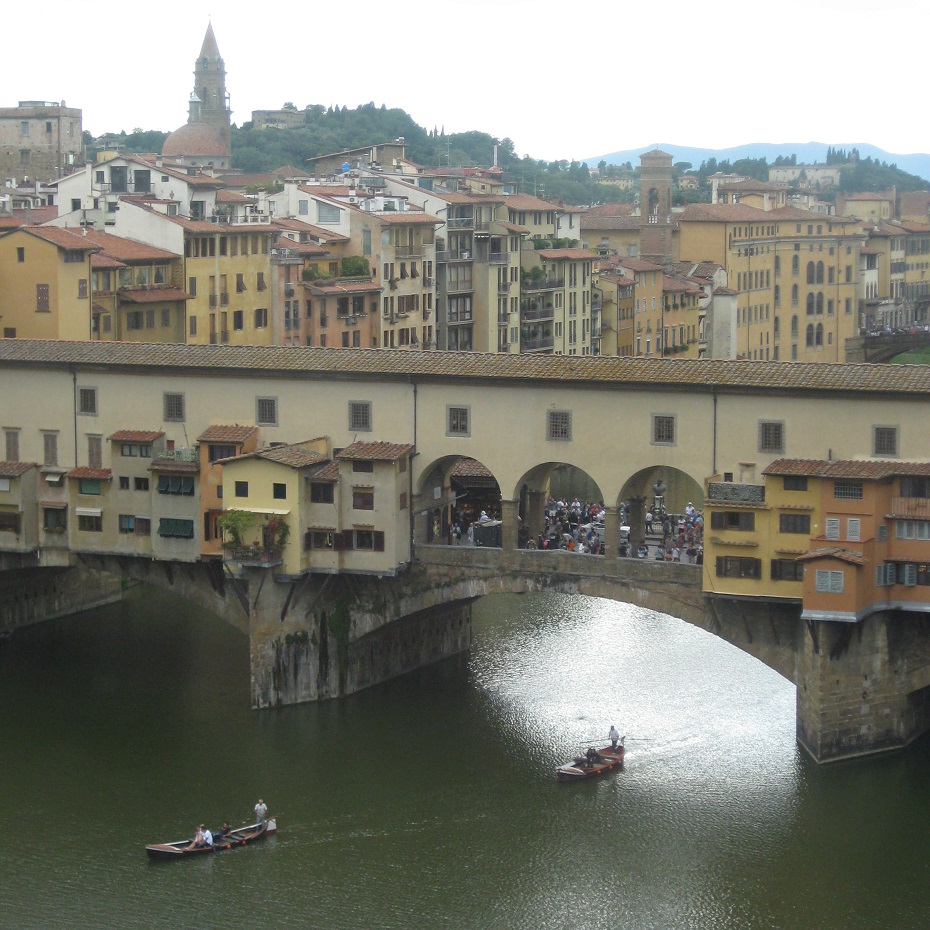 This is a famous bridge with shops on it, which sounded very touristy. We took a photo of it from far away though.
This is a famous bridge with shops on it, which sounded very touristy. We took a photo of it from far away though. - Walk under portico of Mercato Nuovo: This is one of those good luck myths/ rituals: you’re supposed to rub the nose of the famous porcellino and let a coin fall from its mouth. If the coin drops through the grate, then Florence will bring you good fortune, they say. We saw several different porcellinos (giant wart hogs) during our visit, and we got to visit, so that was a lot of good luck already.


It looks like you guys managed to cover a lot of ground and still have plenty to see if you decide to visit again.
Absolutely! B says he could go back and live in Florence – that’s how much he liked it. I’m not opposed, but I think we should probably learn a bit more Italian first. 🙂
Pingback: What We Saw in London | Novelty Buffs
Pingback: What We Saw in Rome | Novelty Buffs
Pingback: Growing a (Temporary) Heart - Novelty Buffs